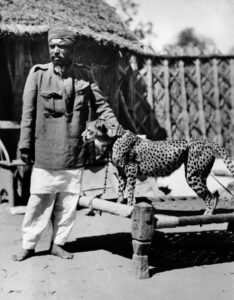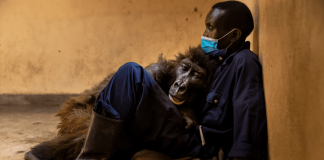JULY 22, 2022

Cheetahs were kept as domestic pets, often chained by the neck in 1930s India. (Keystone-France / via Getty Images file)
Cheetah’s are set to race on the plains of India for the first time since the world’s fastest land animal was driven to extinction in the south Asian country 70 years ago, officials said Wednesday.
African cheetahs will be transported from Namibia to the Kuno Wildlife Sanctuary, a national park in the central state of Madhya Pradesh after a deal was signed with the southern African nation, India’s Ministry of Environment, Forest and Climate Change said in a statement.
Bringing the cheetah back to India will “have important conservation ramifications,” the statement said, adding that they would help to stem the “rapid loss of biodiversity.”
It added that the creatures were “not a threat to humans and usually do not attack large livestock,” and that “bringing back a top predator restores historic evolutionary balance.”
The project’s goal is to restore a cheetah population within the species’ historic range in India, with 50 cheetahs placed in various parks over the next five years, the environment ministry said in a previous statement.
However, Sanjay Gubbi, a conservation biologist based in India who focuses on large wild cats, said that reintroducing cheetahs will be more difficult than prior big cat initiatives.
African cheetahs are a different subspecies from India’s native Asiatic cheetah, he told NBC News in telephone interview Thursday. He added that the predators are “habit specialists” that required large grassland areas of up to 128,000 acres to survive.
“I don’t think India has enough large continuous patches of grassland scrub habitats to support the species anymore,” he said.
Factors such as hunting, habitat destruction, and loss of prey lead to the Indian wild cat going extinct by the early 1950s, according to the International Union for Conservation of Nature’s Cat Specialist Group.
When the cheetahs — which can run up to speeds as high as 75 miles per hour — arrive in India they will be rejoining a lineup of several wild cat species in the country, including the leopard and tiger.
The project will be overseen by the National Tiger Conservation Authority of India which has previously reintroduced tiger populations to the country.
Their new home at the Kuno Wildlife Sanctuary is almost 185,000 acres in size and devoid of human settlements. It can currently home 21 cheetahs in total, the environment ministry’s statement said.
Considered a vulnerable species worldwide, there are fewer than 7,000 cheetahs estimated to be left in the wild, according to the International Union for Conservation of Nature, which says that Namibia has the world’s largest population.
Keen to promote their arrival, a new mascot called “Chintu Cheetah” has been created by the state of Madhya Pradesh.
But its work might be cut out.
“India is accustomed to other large cats, which live in scrub or forest habitats, but not to cheetahs which roam in large fields and open grassland habitats,” said Gubbi, the conservation biologist.
He also warned that smaller livestock, such as sheep and goats, could become cheetah lunch.
“It will be interesting to see how communities will accept new species conflict,” he said.
While he said he agreed that predators like cheetahs can play an important role in the environment, Gubbi said the issue of habitat loss is more pressing to India’s conservation efforts.
Several grassland species in India, including the endangered great Indian bustard are currently at risk of extinction due to habitat loss, according to the World Wildlife Foundation.
“A bird in the hand is worth two in the bush,” said Gubbi. “When we can’t even save what we already have, I’m very skeptical if we are going to be able to reintroduce a new species.”

































































































